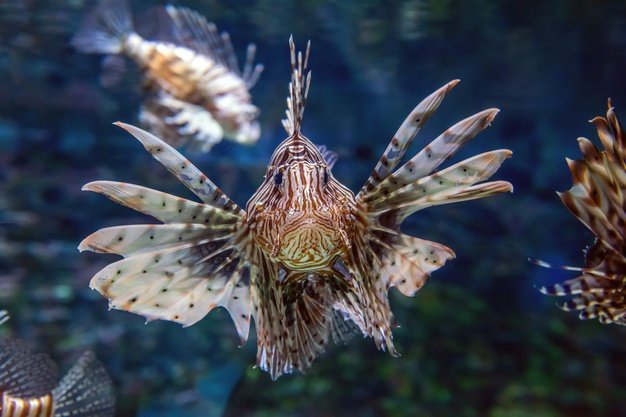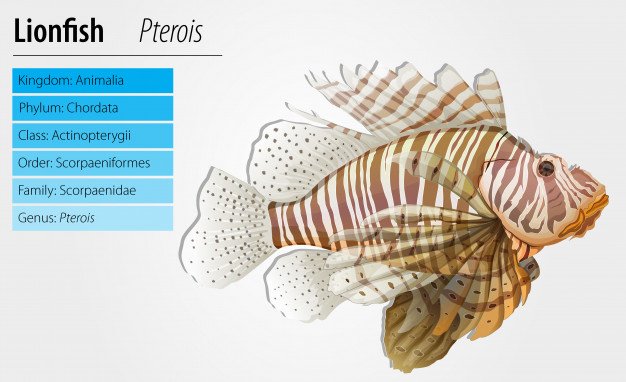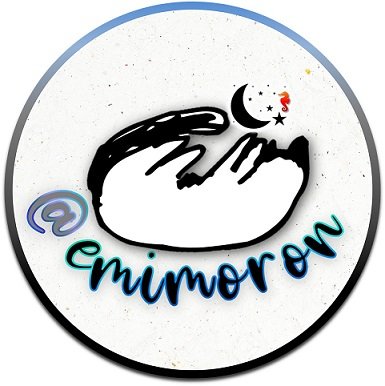Hello to all my friends of Steem Geography, I am a sea lover, I snorkel and dive, my favourite place is on the beaches, seas and oceans. My pending subject is Marine Biology, although it is not my professional career I like to read, research and learn about the marine ecosystem and therefore, I not only admire the fish, reefs and all life in the depths of the sea but also try to raise awareness about the care and importance of the sea for the planet. Today I want to share with you a post dedicated to a truly enigmatic fish, a voracious predator of exuberant beauty, eye-catching and I think little understood. It is the Lionfish.

Source: freepik.es
Este post surge a raíz de unas declaraciones así como artículos que han circulado en las redes desde inicios de este año 2021 acerca del incremento de la presencia del pez León en la Costa de Venezuela, específicamente en el estado Falcón en la costa de Los Roques. Donde la evidente falta de turistas a causa de la pandemia le ha dado la oportunidad a dicho pez de reproducirse más rápidamente causando alarma entre los lugareños, pescadores, dueños de posadas y hoteles cuya actividad de una u otra forma se ha visto afectada por la presencia de este singular pez, debo señalar que los efectos de alarma y descontrol que ha causado el pez León vienen dado más por un desconocimiento de su forma de vida que por el mismo en realidad, de allí este artículo que espera ser de utilidad para quien se encuentre en presencia del Pez León.
This post arises from statements and articles that have been circulating in the networks since the beginning of this year 2021 about the increased presence of lionfish on the coast of Venezuela, specifically in the state of Falcón on the coast of Los Roques. Where the obvious lack of tourists due to the pandemic has given the fish the opportunity to reproduce more quickly causing alarm among locals, fishermen, owners of inns and hotels whose activity in one way or another has been affected by the presence of this unique fish, I must point out that the effects of alarm and lack of control that has caused the Lionfish are given more by a lack of knowledge of their way of life than by the same in reality, hence this article that hopes to be useful for those who find themselves in the presence of the Lionfish.
El pez León este es originario de las aguas del Océano Pacifico Sur y del Índico, de la familia de peces Scorpaenidae puede llegar a pesar hasta 1.2 kg, sus medidas en edad adulta oscilan de 30 a 40cm, la longevidad de este pez está calculada por los investigadores de alrededor de unos 15 años de vida o más, tiene una dieta basada en el consumo voraz de otros peces, es decir es carnívoro. Su hábitat natural se encuentra en los arrecifes ubicados en aguas cálidas de 25°, de allí que haya encontrado en nuestras costas del caribe el lugar perfecto para su hogar, su reproducción es realmente rápida debido a que pueden llegar a poner hasta 2.500.000 huevos por mes.
The Lionfish is native to the waters of the South Pacific Ocean and the Indian Ocean, from the Scorpaenidae fish family can weigh up to 1.2 kg, its adult measurements range from 30 to 40cm, the longevity of this fish is calculated by researchers to be around 15 years of life or more, has a diet based on the voracious consumption of other fish, ie carnivorous. Its natural habitat is found in reefs located in warm waters of 25°, which is why it has found the perfect place for its home on our Caribbean coasts. Its reproduction is really fast, as it can lay up to 2,500,000 eggs per month.

Source:freepik.es
El pez León no tiene depredador natural, el en cambio es el responsable del descenso de otras especies de peces, su apetito voraz lo hace consumir grandes cantidades de otras peces lo que en la actualidad es un problema que amerita su atención. El único depredador de nuestro amigo es el ser humano, incluso en los Roques aquí en Venezuela los pescadores se están organizando para poder comenzar su pesca controlada, mientras expertos en especies de peces y de alta cocina como el chef Juan Seara han creado platos para diversos restaurantes cuyo centro es el filete de pez león, para este chef es de suma importancia la educación de los pescadores con respecto al Pez León en materia de pesca, proceso de preparación y consumo, debido a que, incluirlo como parte de la dieta de los lugareños y visitantes donde hay sobrepoblación de este pez es una forma de controlar su incremento y salvaguardar a otras especies.
The lionfish has no natural predator, instead it is responsible for the decline of other fish species, its voracious appetite makes it consume large quantities of other fish, which is currently a problem that deserves attention. The only predator of our friend is the human being, even in the Roques here in Venezuela the fishermen are organising themselves to be able to start controlled fishing, while experts in fish species and haute cuisine such as chef Juan Seara have created dishes for various restaurants whose centrepiece is the lionfish fillet, For this chef, it is of utmost importance to educate fishermen about lionfish fishing, preparation and consumption, because including it as part of the diet of locals and visitors where there is an overpopulation of this fish is a way to control its increase and safeguard other species.
Otra de las formas de control ha sido propuesta en el Caribe, por los investigadores de “Robots al Servicio del entorno” (RSE), que han creado el “Lionfish Terminator”. El cual tiene como función pescar selectivamente el pez león para controlar la población y de esta manera proteger el ecosistema. Sin embargo, este es un modelo que está en fase de prototipo y del cual aún hay mucho que decir pues su función es el exterminar el pez como si te tratara de una plaga lo cual ha generado mucha polémica entre los defensores de la vida marina. Hasta ahora lo más adecuado es la pesca cuya finalidad sea el consumo humano.
Another form of control has been proposed in the Caribbean, by researchers from Robots Serving the Environment (RSE), who have created the Lionfish Terminator. Its function is to selectively catch lionfish in order to control the population and thus protect the ecosystem. However, this model is still in the prototype phase and there is still much to be said about it, as its function is to exterminate the fish as if it were a pest, which has generated a lot of controversy among defenders of marine life. So far, it is best suited to fishing for human consumption.
Una de los puntos claves es saber retirar las espinas del pez león las cuales tienen un concentrado y potente veneno, estos peces tienen espinas dorsales relativamente delgadas y largas con glándulas de veneno pequeñas al final de estas, su picadura es relativamente indolora al principio pero en pocos minutos el dolor puede extremadamente fuerte y paralizante todo depende de la cantidad de veneno que nos haya depositado el pez, cabe destacar que no es mortal sólo causa efectos dolorosos y desagradables en el organismo pero no la muerte inmediata como algunas personas que desconocen del tema quieren hacernos creer.
One of the key points is to know how to remove the spines of the lionfish which have a concentrated and potent venom, these fish have relatively thin and long dorsal spines with small venom glands at the end of these, their bite is relatively painless at first but in a few minutes the pain can be extremely strong and paralysing depending on the amount of venom that the fish has deposited, it should be noted that it is not fatal only causes painful and unpleasant effects on the body but not immediate death as some people who do not know the subject want us to believe.
Según Cortazares, Campos y Moreno (2008) la picadura de pez león no es muy diferente de cualquier picadura de un animal venenoso y en la persona produce: dolor local y edema, síntomas sistémicos con náusea, mareos, debilidad muscular, disnea, hipertensión, cefalea y algunos casos necrosis del tejido afectado. Es común que ocurran linfangitis y linfadenitis fiebre, dolor de las articulaciones e infecciones bacterianas secundarias, el edema y el dolor disminuyen de manera gradual y en algunos casos puede continuar por dos o tres meses.
According to Cortazar, Campos and Moreno (2008) the lionfish bite is not very different from any bite of a venomous animal and in the person produces: local pain and oedema, systemic symptoms with nausea, dizziness, muscle weakness, dyspnoea, hypertension, headache and in some cases necrosis of the affected tissue. Lymphangitis and lymphadenitis, fever, joint pain and secondary bacterial infections are common, oedema and pain subside gradually and in some cases may continue for two to three months.
Para no hacer más largo el post en otra oportunidad continuaré hablando de este pez que nos desconcierta, llama la atención y del que en cierta forma nos falta mucho por aprender.
In order not to make this post longer, another time I will continue talking about this fish that baffles us, attracts our attention and about which, in a way, we still have a lot to learn.
Referencias
Cortazares, J.; Campos, J.; Moreno, J. (2008) Envenenamiento por Picadura de Pez León. Revista Digital Medigraphic Artemisa en Línea. Bol Clin Hosp Infant Edo Son 2008; 25(2): 85-90. Disponible en: https://www.medigraphic.com/pdfs/bolclinhosinfson/bis-2008/bis082h.pdf
References
Cortazares, J.; Campos, J.; Moreno, J. (2008) Lionfish Sting Poisoning. Revista Digital Medigraphic Artemisa en Línea. Bol Clin Hosp Infant Edo Son 2008; 25(2): 85-90. Available at: https://www.medigraphic.com/pdfs/bolclinhosinfson/bis-2008/bis082h.pdf
